Olaf Wysocki
RADLER: Radar Object Detection Leveraging Semantic 3D City Models and Self-Supervised Radar-Image Learning
Apr 16, 2025Abstract:Semantic 3D city models are worldwide easy-accessible, providing accurate, object-oriented, and semantic-rich 3D priors. To date, their potential to mitigate the noise impact on radar object detection remains under-explored. In this paper, we first introduce a unique dataset, RadarCity, comprising 54K synchronized radar-image pairs and semantic 3D city models. Moreover, we propose a novel neural network, RADLER, leveraging the effectiveness of contrastive self-supervised learning (SSL) and semantic 3D city models to enhance radar object detection of pedestrians, cyclists, and cars. Specifically, we first obtain the robust radar features via a SSL network in the radar-image pretext task. We then use a simple yet effective feature fusion strategy to incorporate semantic-depth features from semantic 3D city models. Having prior 3D information as guidance, RADLER obtains more fine-grained details to enhance radar object detection. We extensively evaluate RADLER on the collected RadarCity dataset and demonstrate average improvements of 5.46% in mean avarage precision (mAP) and 3.51% in mean avarage recall (mAR) over previous radar object detection methods. We believe this work will foster further research on semantic-guided and map-supported radar object detection. Our project page is publicly available athttps://gpp-communication.github.io/RADLER .
Texture2LoD3: Enabling LoD3 Building Reconstruction With Panoramic Images
Apr 07, 2025Abstract:Despite recent advancements in surface reconstruction, Level of Detail (LoD) 3 building reconstruction remains an unresolved challenge. The main issue pertains to the object-oriented modelling paradigm, which requires georeferencing, watertight geometry, facade semantics, and low-poly representation -- Contrasting unstructured mesh-oriented models. In Texture2LoD3, we introduce a novel method leveraging the ubiquity of 3D building model priors and panoramic street-level images, enabling the reconstruction of LoD3 building models. We observe that prior low-detail building models can serve as valid planar targets for ortho-rectifying street-level panoramic images. Moreover, deploying segmentation on accurately textured low-level building surfaces supports maintaining essential georeferencing, watertight geometry, and low-poly representation for LoD3 reconstruction. In the absence of LoD3 validation data, we additionally introduce the ReLoD3 dataset, on which we experimentally demonstrate that our method leads to improved facade segmentation accuracy by 11% and can replace costly manual projections. We believe that Texture2LoD3 can scale the adoption of LoD3 models, opening applications in estimating building solar potential or enhancing autonomous driving simulations. The project website, code, and data are available here: https://wenzhaotang.github.io/Texture2LoD3/.
FacaDiffy: Inpainting Unseen Facade Parts Using Diffusion Models
Feb 20, 2025Abstract:High-detail semantic 3D building models are frequently utilized in robotics, geoinformatics, and computer vision. One key aspect of creating such models is employing 2D conflict maps that detect openings' locations in building facades. Yet, in reality, these maps are often incomplete due to obstacles encountered during laser scanning. To address this challenge, we introduce FacaDiffy, a novel method for inpainting unseen facade parts by completing conflict maps with a personalized Stable Diffusion model. Specifically, we first propose a deterministic ray analysis approach to derive 2D conflict maps from existing 3D building models and corresponding laser scanning point clouds. Furthermore, we facilitate the inpainting of unseen facade objects into these 2D conflict maps by leveraging the potential of personalizing a Stable Diffusion model. To complement the scarcity of real-world training data, we also develop a scalable pipeline to produce synthetic conflict maps using random city model generators and annotated facade images. Extensive experiments demonstrate that FacaDiffy achieves state-of-the-art performance in conflict map completion compared to various inpainting baselines and increases the detection rate by $22\%$ when applying the completed conflict maps for high-definition 3D semantic building reconstruction. The code is be publicly available in the corresponding GitHub repository: https://github.com/ThomasFroech/InpaintingofUnseenFacadeObjects
CDGS: Confidence-Aware Depth Regularization for 3D Gaussian Splatting
Feb 20, 2025Abstract:3D Gaussian Splatting (3DGS) has shown significant advantages in novel view synthesis (NVS), particularly in achieving high rendering speeds and high-quality results. However, its geometric accuracy in 3D reconstruction remains limited due to the lack of explicit geometric constraints during optimization. This paper introduces CDGS, a confidence-aware depth regularization approach developed to enhance 3DGS. We leverage multi-cue confidence maps of monocular depth estimation and sparse Structure-from-Motion depth to adaptively adjust depth supervision during the optimization process. Our method demonstrates improved geometric detail preservation in early training stages and achieves competitive performance in both NVS quality and geometric accuracy. Experiments on the publicly available Tanks and Temples benchmark dataset show that our method achieves more stable convergence behavior and more accurate geometric reconstruction results, with improvements of up to 2.31 dB in PSNR for NVS and consistently lower geometric errors in M3C2 distance metrics. Notably, our method reaches comparable F-scores to the original 3DGS with only 50% of the training iterations. We expect this work will facilitate the development of efficient and accurate 3D reconstruction systems for real-world applications such as digital twin creation, heritage preservation, or forestry applications.
ZAHA: Introducing the Level of Facade Generalization and the Large-Scale Point Cloud Facade Semantic Segmentation Benchmark Dataset
Nov 07, 2024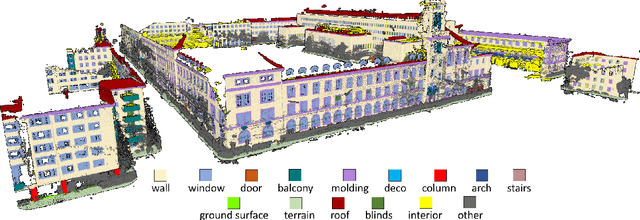
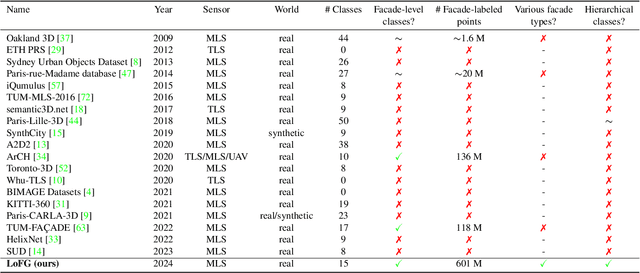
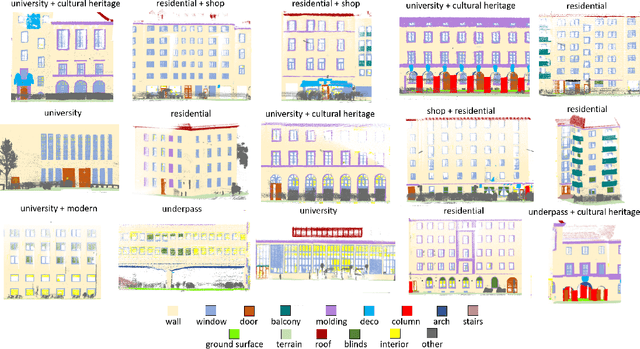
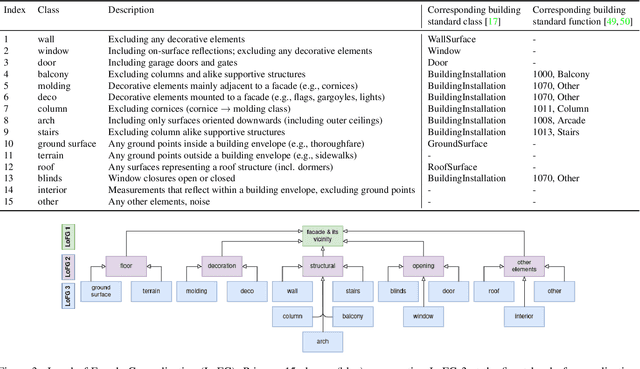
Abstract:Facade semantic segmentation is a long-standing challenge in photogrammetry and computer vision. Although the last decades have witnessed the influx of facade segmentation methods, there is a lack of comprehensive facade classes and data covering the architectural variability. In ZAHA, we introduce Level of Facade Generalization (LoFG), novel hierarchical facade classes designed based on international urban modeling standards, ensuring compatibility with real-world challenging classes and uniform methods' comparison. Realizing the LoFG, we present to date the largest semantic 3D facade segmentation dataset, providing 601 million annotated points at five and 15 classes of LoFG2 and LoFG3, respectively. Moreover, we analyze the performance of baseline semantic segmentation methods on our introduced LoFG classes and data, complementing it with a discussion on the unresolved challenges for facade segmentation. We firmly believe that ZAHA shall facilitate further development of 3D facade semantic segmentation methods, enabling robust segmentation indispensable in creating urban digital twins.
Analyzing the impact of semantic LoD3 building models on image-based vehicle localization
Jul 31, 2024
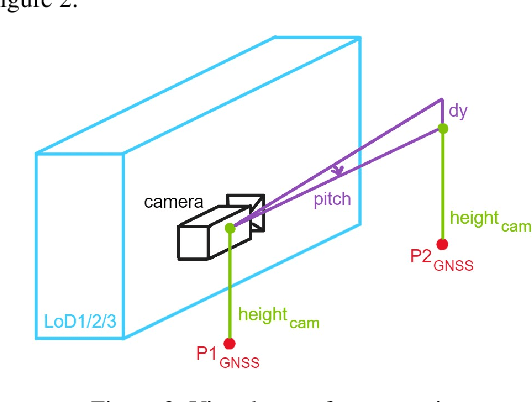
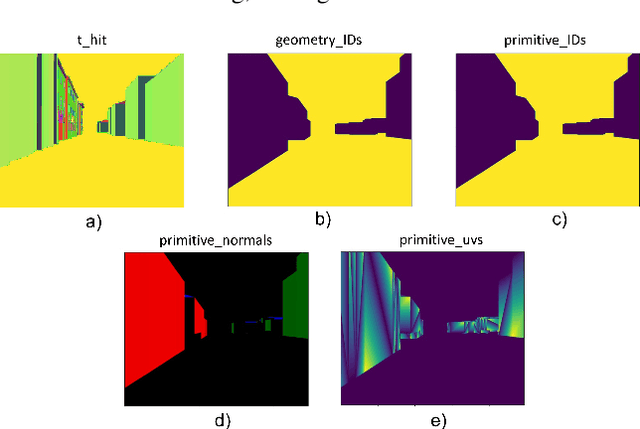
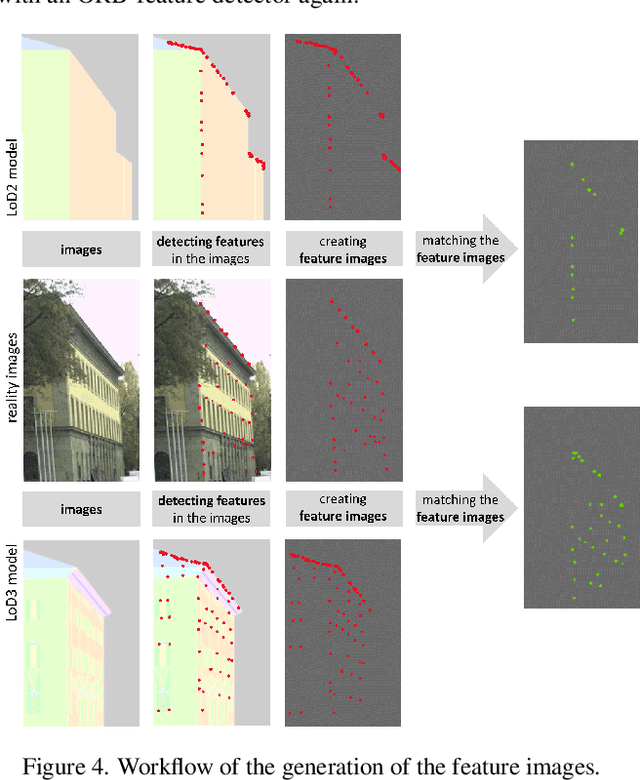
Abstract:Numerous navigation applications rely on data from global navigation satellite systems (GNSS), even though their accuracy is compromised in urban areas, posing a significant challenge, particularly for precise autonomous car localization. Extensive research has focused on enhancing localization accuracy by integrating various sensor types to address this issue. This paper introduces a novel approach for car localization, leveraging image features that correspond with highly detailed semantic 3D building models. The core concept involves augmenting positioning accuracy by incorporating prior geometric and semantic knowledge into calculations. The work assesses outcomes using Level of Detail 2 (LoD2) and Level of Detail 3 (LoD3) models, analyzing whether facade-enriched models yield superior accuracy. This comprehensive analysis encompasses diverse methods, including off-the-shelf feature matching and deep learning, facilitating thorough discussion. Our experiments corroborate that LoD3 enables detecting up to 69\% more features than using LoD2 models. We believe that this study will contribute to the research of enhancing positioning accuracy in GNSS-denied urban canyons. It also shows a practical application of under-explored LoD3 building models on map-based car positioning.
Enriching thermal point clouds of buildings using semantic 3D building modelsenriching thermal point clouds of buildings using semantic 3D building models
Jul 31, 2024Abstract:Thermal point clouds integrate thermal radiation and laser point clouds effectively. However, the semantic information for the interpretation of building thermal point clouds can hardly be precisely inferred. Transferring the semantics encapsulated in 3D building models at LoD3 has a potential to fill this gap. In this work, we propose a workflow enriching thermal point clouds with the geo-position and semantics of LoD3 building models, which utilizes features of both modalities: The proposed method can automatically co-register the point clouds from different sources and enrich the thermal point cloud in facade-detailed semantics. The enriched thermal point cloud supports thermal analysis and can facilitate the development of currently scarce deep learning models operating directly on thermal point clouds.
Classifying point clouds at the facade-level using geometric features and deep learning networks
Feb 09, 2024Abstract:3D building models with facade details are playing an important role in many applications now. Classifying point clouds at facade-level is key to create such digital replicas of the real world. However, few studies have focused on such detailed classification with deep neural networks. We propose a method fusing geometric features with deep learning networks for point cloud classification at facade-level. Our experiments conclude that such early-fused features improve deep learning methods' performance. This method can be applied for compensating deep learning networks' ability in capturing local geometric information and promoting the advancement of semantic segmentation.
Transferring facade labels between point clouds with semantic octrees while considering change detection
Feb 09, 2024Abstract:Point clouds and high-resolution 3D data have become increasingly important in various fields, including surveying, construction, and virtual reality. However, simply having this data is not enough; to extract useful information, semantic labeling is crucial. In this context, we propose a method to transfer annotations from a labeled to an unlabeled point cloud using an octree structure. The structure also analyses changes between the point clouds. Our experiments confirm that our method effectively transfers annotations while addressing changes. The primary contribution of this project is the development of the method for automatic label transfer between two different point clouds that represent the same real-world object. The proposed method can be of great importance for data-driven deep learning algorithms as it can also allow circumventing stochastic transfer learning by deterministic label transfer between datasets depicting the same objects.
MLS2LoD3: Refining low LoDs building models with MLS point clouds to reconstruct semantic LoD3 building models
Feb 09, 2024Abstract:Although highly-detailed LoD3 building models reveal great potential in various applications, they have yet to be available. The primary challenges in creating such models concern not only automatic detection and reconstruction but also standard-consistent modeling. In this paper, we introduce a novel refinement strategy enabling LoD3 reconstruction by leveraging the ubiquity of lower LoD building models and the accuracy of MLS point clouds. Such a strategy promises at-scale LoD3 reconstruction and unlocks LoD3 applications, which we also describe and illustrate in this paper. Additionally, we present guidelines for reconstructing LoD3 facade elements and their embedding into the CityGML standard model, disseminating gained knowledge to academics and professionals. We believe that our method can foster development of LoD3 reconstruction algorithms and subsequently enable their wider adoption.
 Add to Chrome
Add to Chrome Add to Firefox
Add to Firefox Add to Edge
Add to Edge